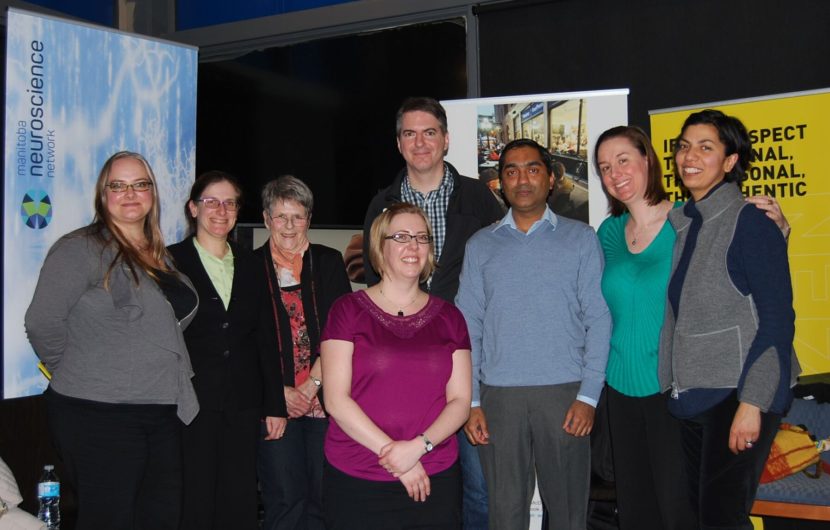Neurocraft panel discussion: exploring the relationship between neuroscience and art

“Brainstorming: What Can Art and Neuroscience Learn from Each Other?” attracted many art lovers and science enthusiasts to the Winnipeg Free Press News Café on March 16th. In celebration of the Neurocraft exhibit, several of its collaborators came together to speak to the public about their Neurocraft experience and the interplay between two seemingly disconnected disciplines (science and art). The panelists included Drs. Michael Jackson, Melanie Martin, and Tabrez Siddiqui, and artists, Lesley Nakonechny, Dana Kletke, and Gaetanne Sylvester. The session was moderated by Dr. Sari Hannila (Manitoba Neuroscience Network Director of Outreach and creator of Neurocraft) and Seema Goel, who curated the exhibit.
Two-years ago, nine pairs of neuroscientists and artists began their Neurocraft journey. Of his first time working with Lesley Nakonechny, Dr. Michael Jackson said, “This gave us a chance to discuss some of the science that we do. And then Lesley would just run off and call me a few weeks later and show me some of her works.” Together they would go on to create a unique print series utilizing a portrait of his father. “I actually saw the first print which to me looked like my father was a comic book hero, but her idea was then to illustrate the loss of self with Alzheimer’s disease by making these successive prints,” he said.
Through the collaborative pairings, many of the neuroscientists discovered similarities between being a scientist and an artist. “I was amazed by Ash’s passion. She loves what she was doing. She was trained in a completely different background than me, but she seemed to have the same exact passion,” said Dr. Melanie Martin during the discussion.
She also goes on to explain that art can be used as a tool to scientists. “I find in some ways, it’s difficult for me to tell people what I do. I felt like she (Ash) was taking what I was doing and interpreting it, and then explaining it.”
When asked if any of the scientists have been inspired by the experience to create art themselves, Dr. Tabrez Siddiqui and Dr. Michael Jackson said they connect to the arts in different ways. For Dr. Siddiqui it’s through poetry, while for Dr. Jackson his connection is through photography or as a consumer of art like film or music.
What Neurocraft has come to demonstrate is that, while neuroscience and art are on seemingly opposite ends of the spectrum, they are actually two-sides of the same coin. One needs only to look at the detailed drawings of brain cells by Santiago Ramón y Cajal to see this. He was not only the father of modern neuroscience but also a brilliant artist that shaped the current understanding of the brain through his drawings. In fact, in many ways a scientist is an artist. From the colourful microscopic images of brain cells artfully arranged for publication to the PowerPoint presentations used to explain one’s research, there are more connections between art and neuroscience than you’d think.
The Neurocraft panel discussion was presented by the Manitoba Neuroscience Network and the Manitoba Craft Council.
| Contributor | —Crystal Acosta |
| Credit | —Crystal Acosta |